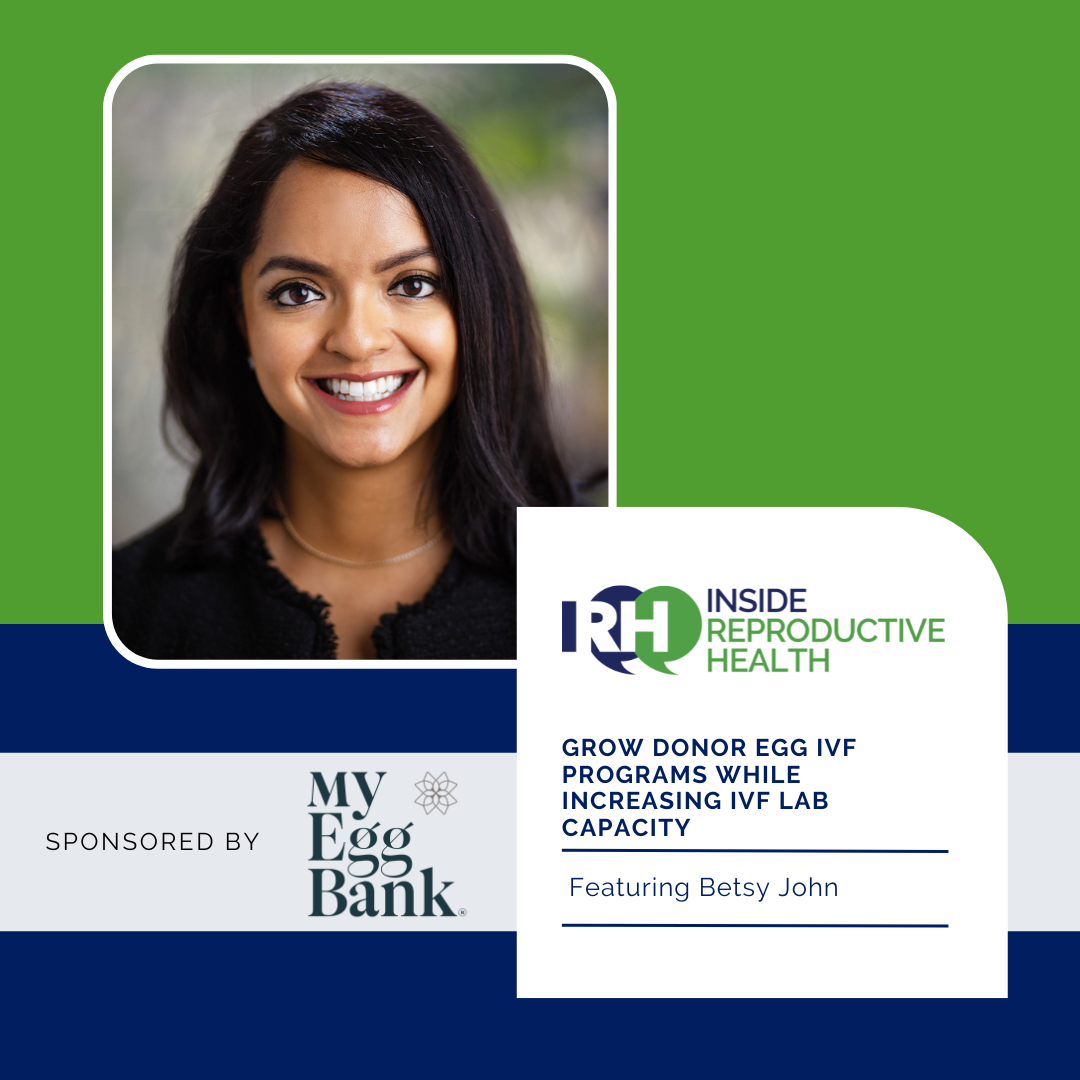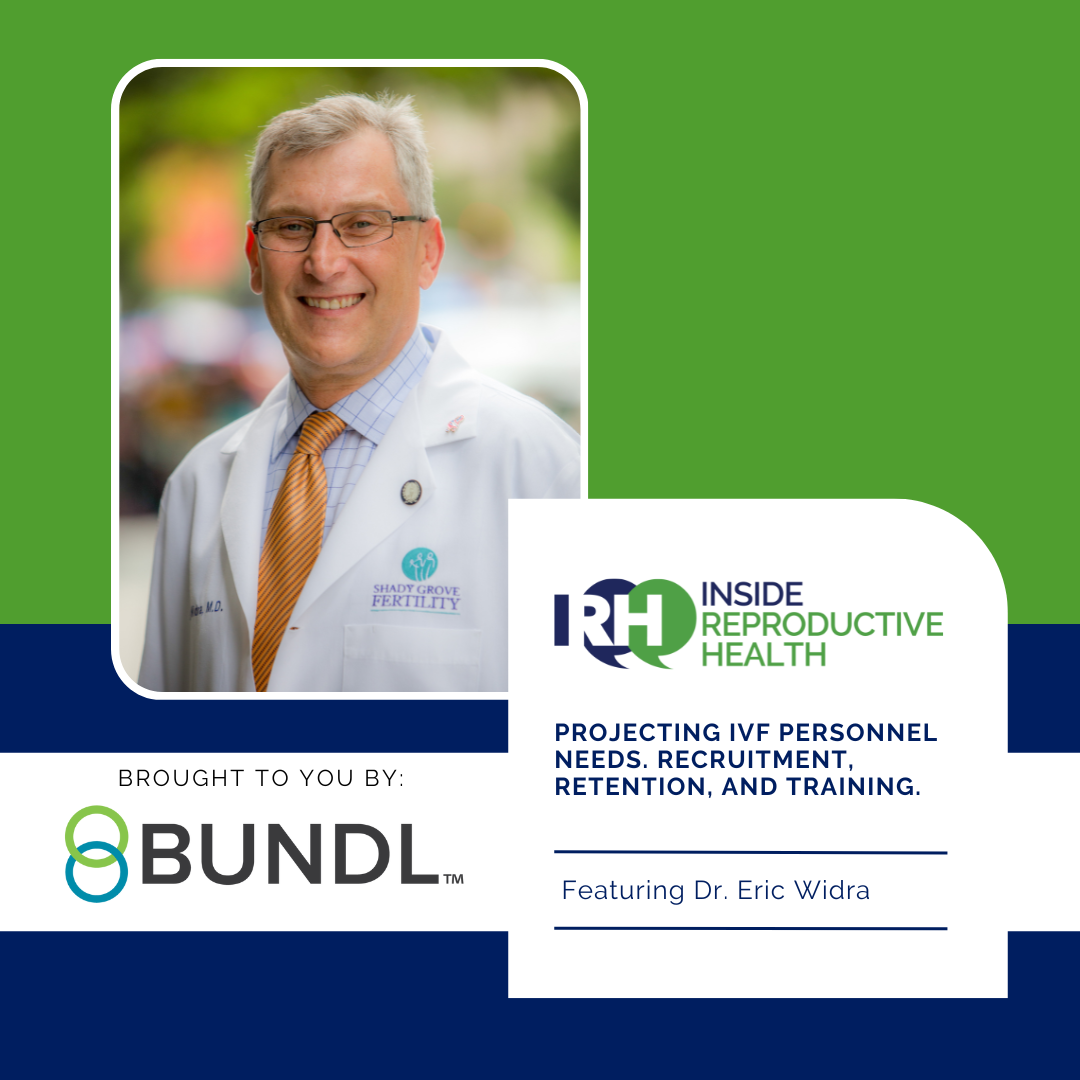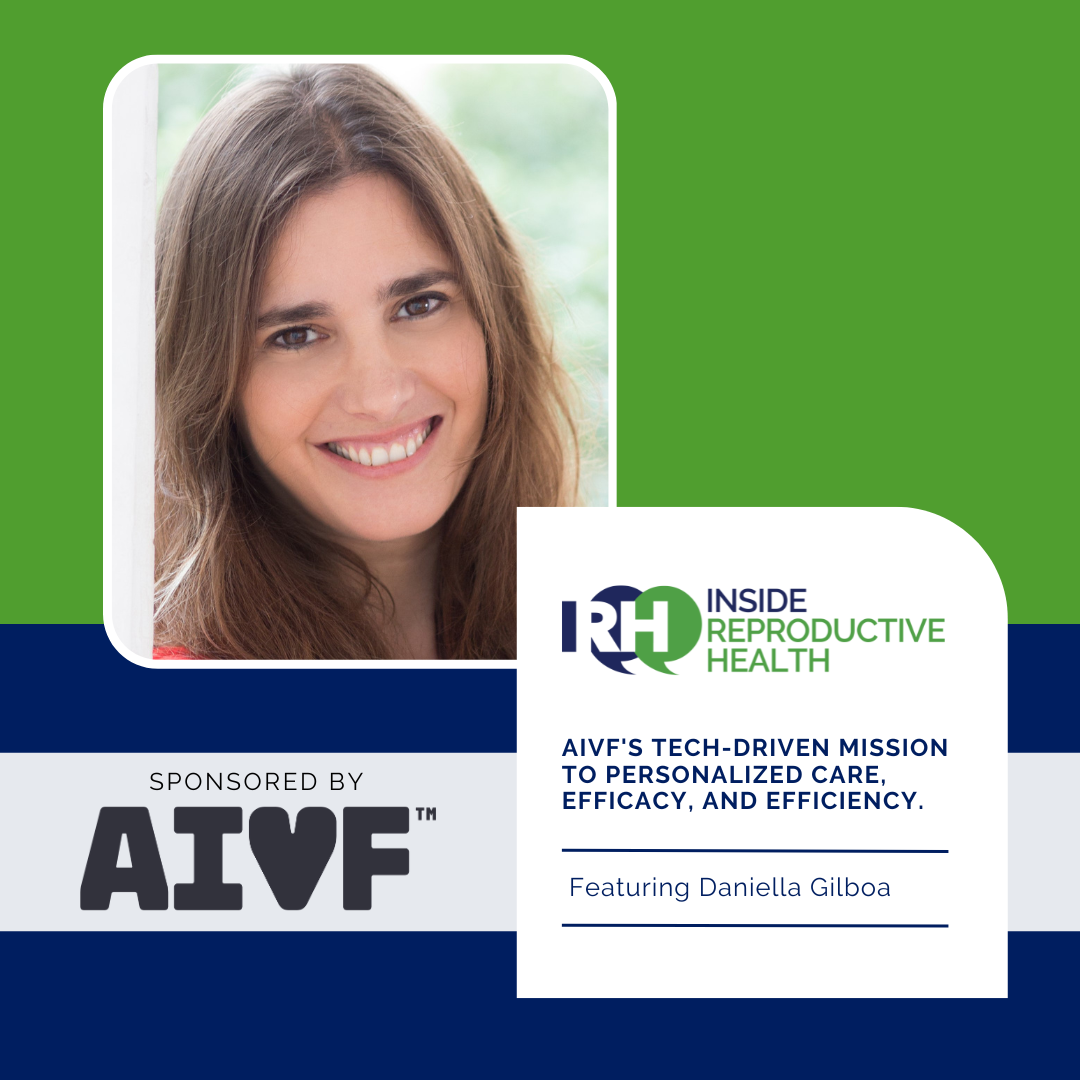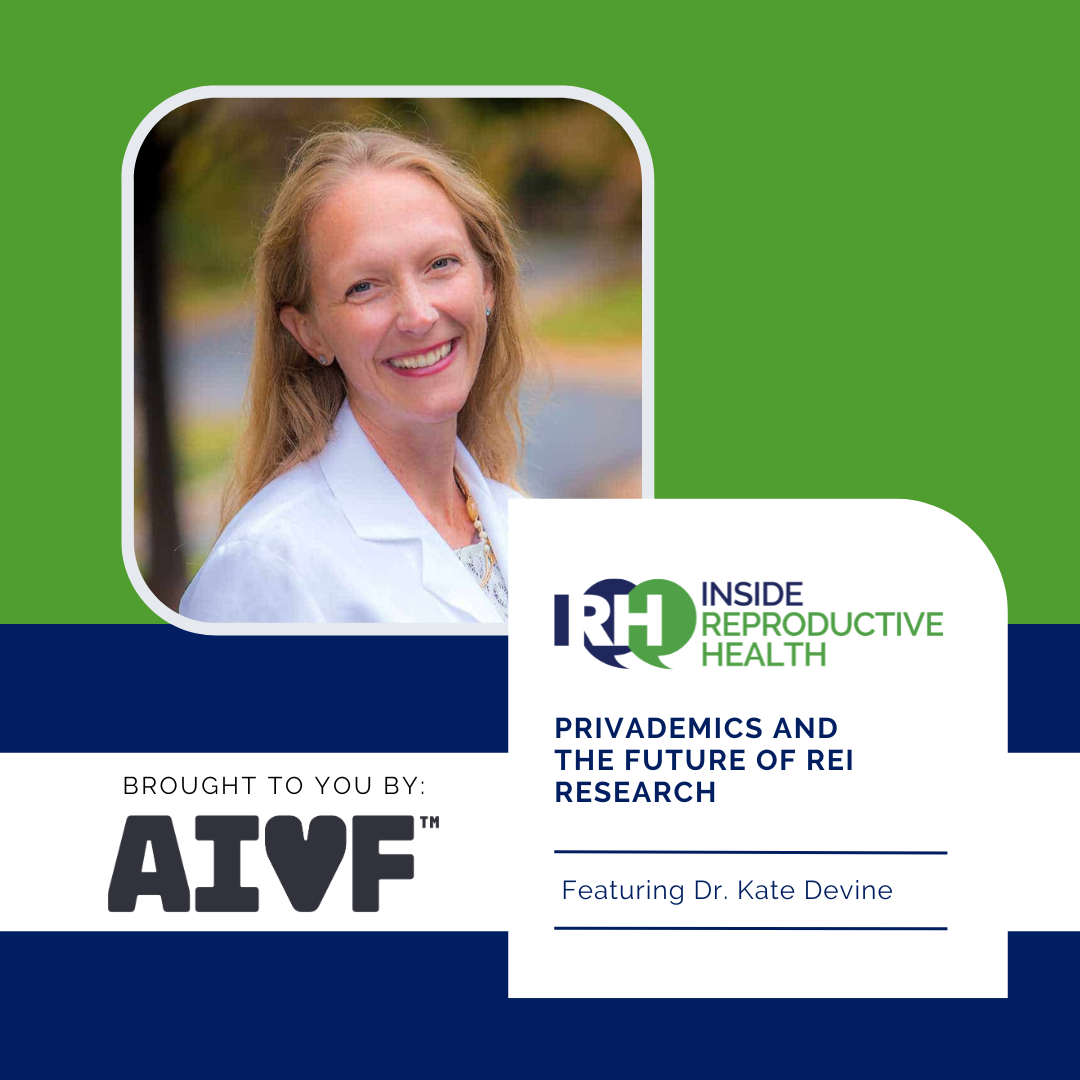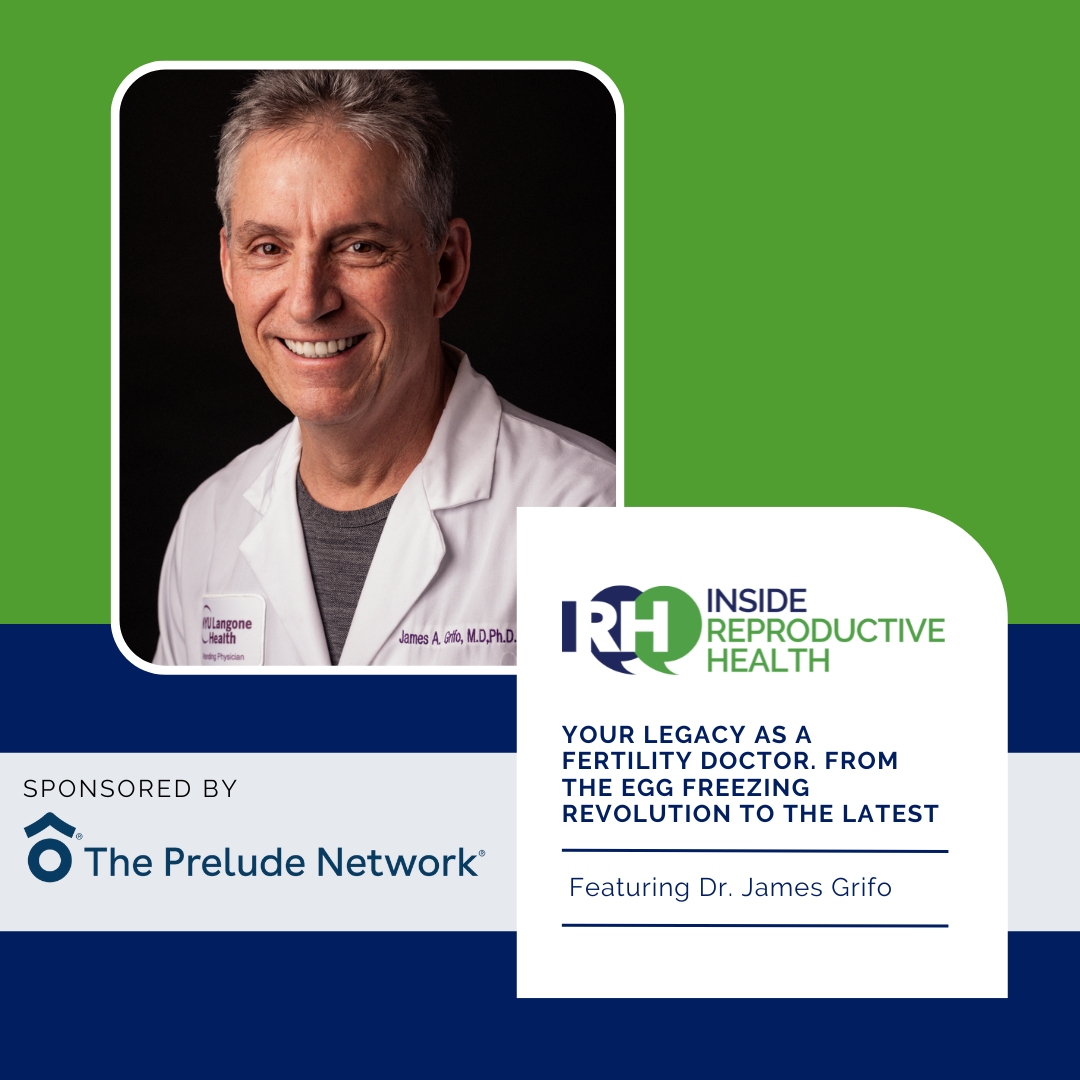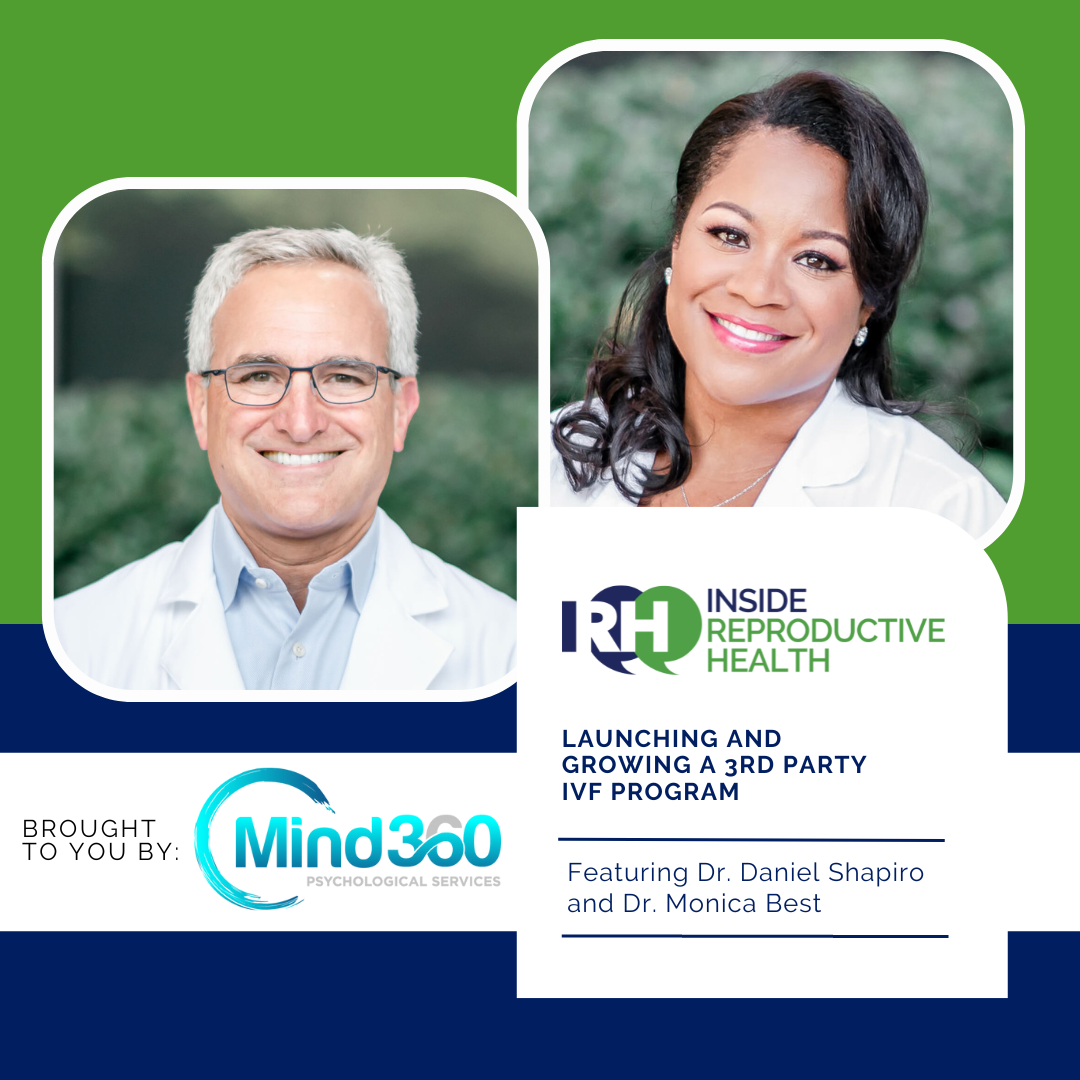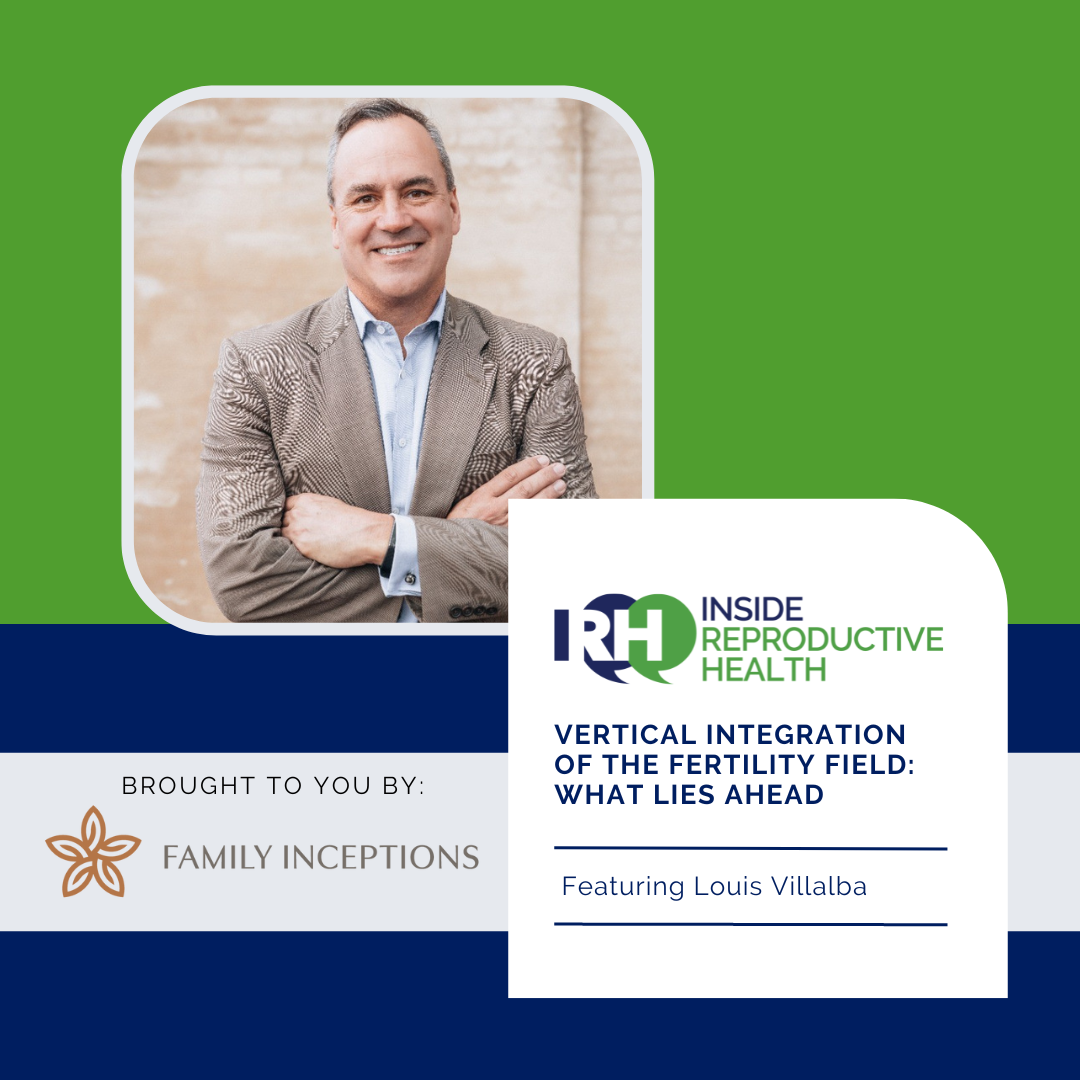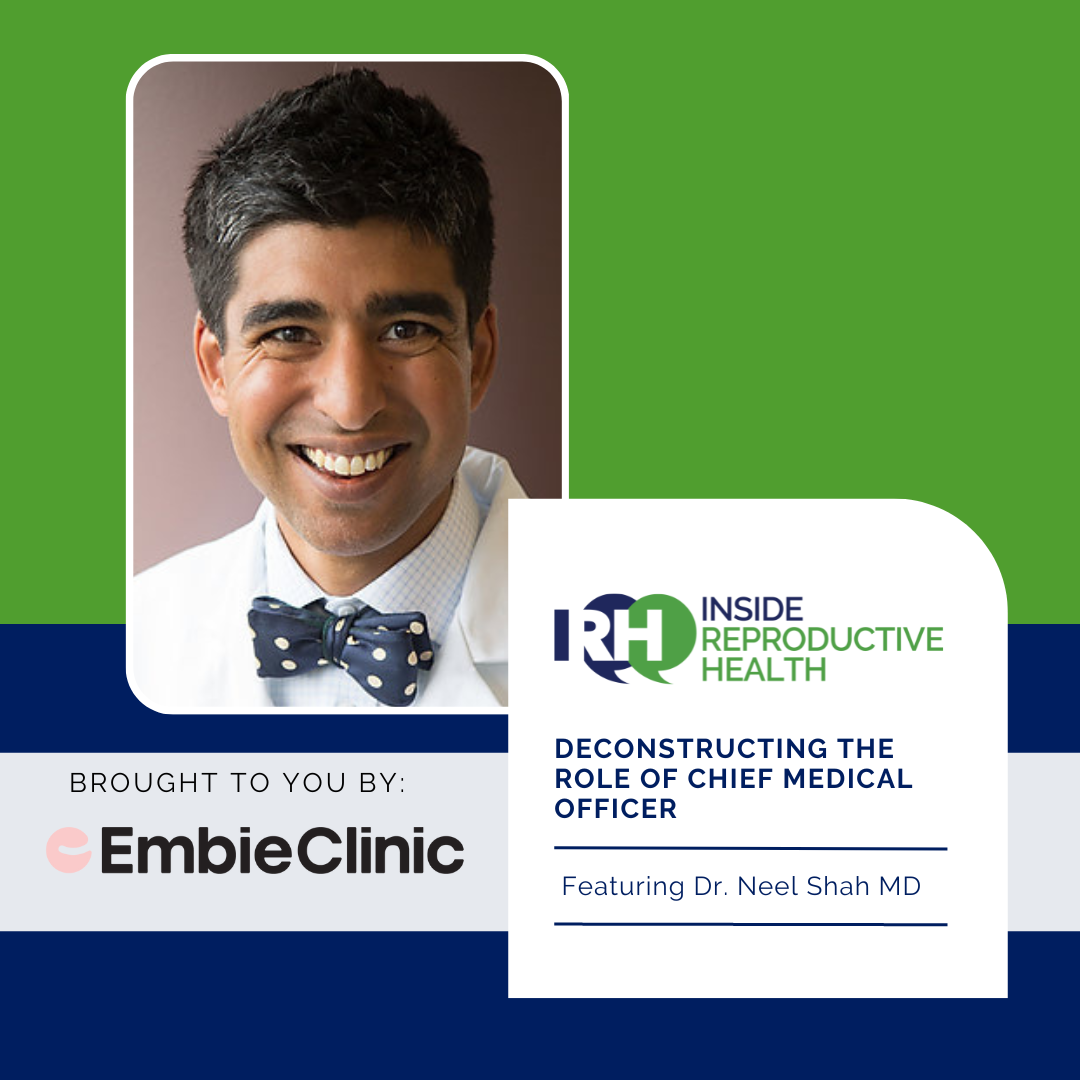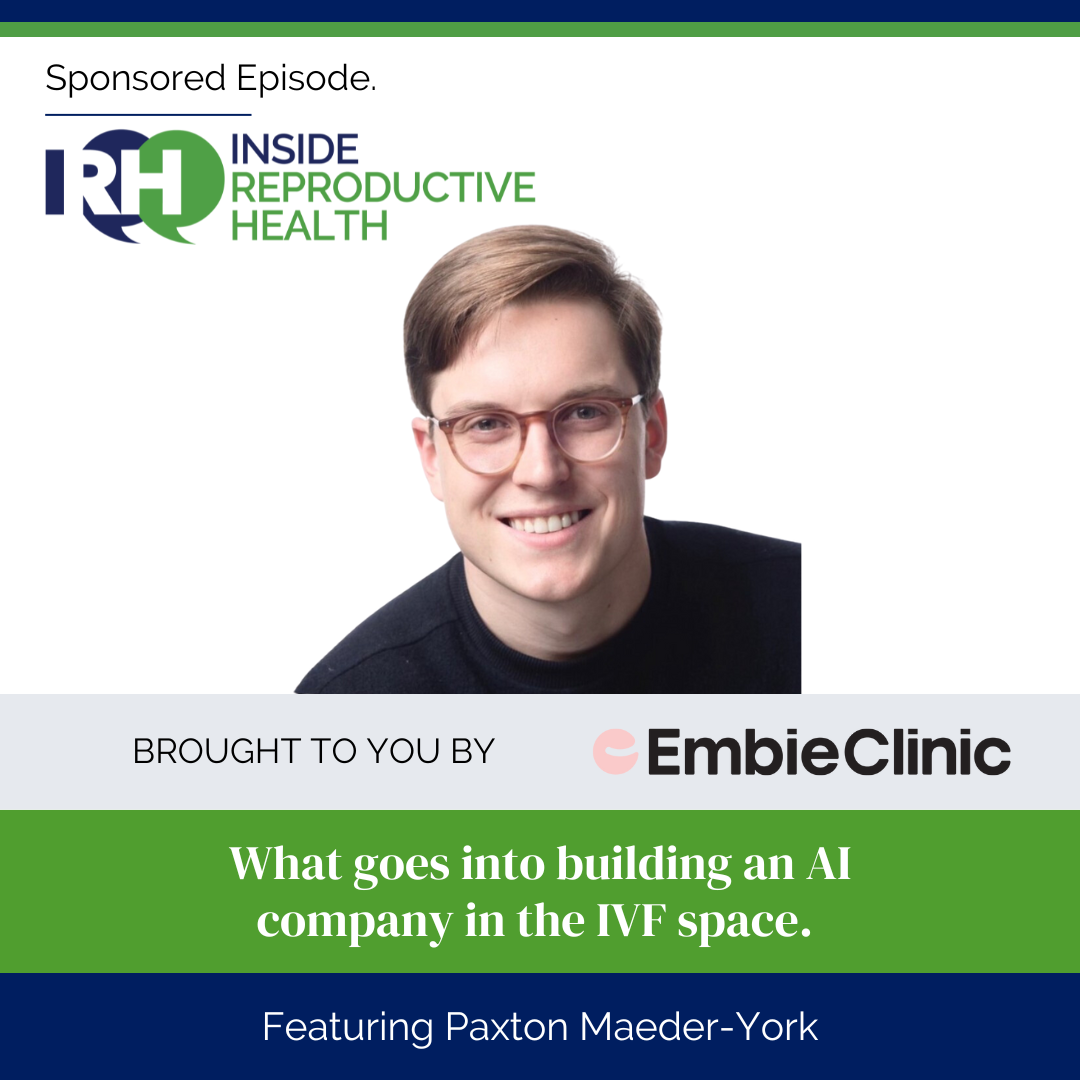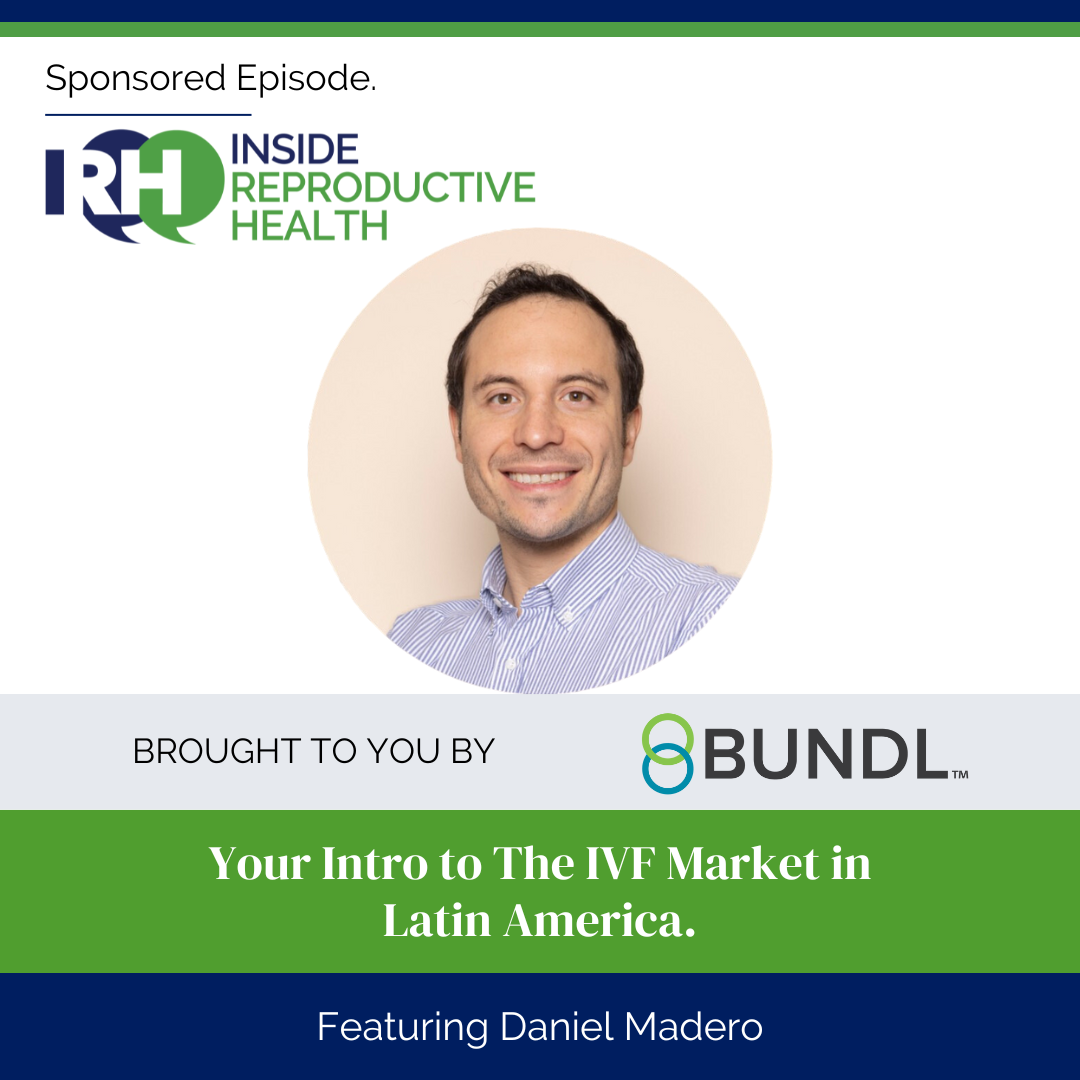DISCLAIMER: Today’s episode is paid content from our feature sponsor, who helps Inside Reproductive Health to deliver information for free, to you! Here, the Advertiser has editorial control. Feature sponsorship is not an endorsement, and does not necessarily reflect the views of Inside Reproductive Health.
Capacity, Reach, and Concierge Service.
Betsy John, Business Development Manager at My Egg Bank, shares how these three systems are necessary to growing your 3rd party IVF program.
With Betsy we discuss:
What Concierge Service looks like when serving your patients
The burden 3rd party nurses have (And how you can alleviate that burden)
The diversity of egg donors required for fertility practices to grow their 3rd party programs
What fertility practices should avoid when working with a new egg bank
The trends she sees on the horizon for donor egg IVF (Including AI for facial recognition)
Why offering both fresh and frozen donor cycles is necessary (and how My Egg Bank helps with each)
Betsy John
LinkedIn
MyEggBank
LinkedIn
Facebook
Instagram
Twitter
Transcript
[00:00:00] Betsy John: To be honest, it is more one on one. So I guess more so in the vein of the concierge service, that it's not, something that we do. And it really is more so about to meet those intended parents where they're at in the journey. As I mentioned, some of them are coming to us, all of this is brand new. They feel so confused or overwhelmed by the process.
but I think that's where the personal touch really matters. That maybe a module or a video wouldn't be able to afford the same, open communication that a conversation with that person might have.
[00:00:34] Sponsor: This episode was made possible by our feature sponsor, MyEggBank, the premier network of donor egg banks.
Enhance your clinic's fertility services with MyEggBank. By joining our network, your clinic can broaden its horizons, offering aspiring parents a diverse range of fresh and frozen donor egg options, each backed by our demonstrated success rates. Together, we can bring the joy and hope of parenthood to more families.
Discover the benefits of partnering with MyEggBank by visiting myeggbank.com/irh. That's myeggbank.com/irh.
Announcer: Today's episode is paid content from our future sponsor, who helps Inside Reproductive Health to deliver information for free to you. Here, the advertiser has editorial control. Feature sponsorship is not an endorsement and does not necessarily reflect the views of inside reproductive health.
[00:01:33] Griffin Jones: Capacity, reach, concierge service. Those are three themes that come to mind when condensing what's necessary. To grow your third party IVF program. And can you grow your third party IVF program, not just without straining your capacity in the clinic and the lab, but adding to your capacity in the clinic and the lab, I explore how fertility practices are leveraging these systems to grow their third party programs, particularly.
They're donor egg IVF programs. And I do so with Betsy John. Betsy is the business development manager of MyEggBank. She's worked there almost 12 years. And I think she's someone you'd like to know. I think she's someone that in some years time, you're going to enjoy saying. Oh, I knew her from that podcast episode.
I connected with her after she came out on that podcast episode. Here's what we talk about. We talk about what concierge service looks like when serving your patients. We talk about quality controls. We talk about the burden that third party nurses have, third party coordinators, third party directors have, and what you might be able to do to alleviate that burden.
We talk about my bank's massive capacity, nearly 200 egg donors in any given time. Not an application phase ready to go. We talk about the scope and diversity, the fertility practices need from their egg donor population in order to be able to grow their programs. We talk about how being able to offer both fresh and frozen donor cycles is necessary and how MyEggBank helps with each.
We talk about embryo banking. Being able to purchase all the eggs from a donor. And we talk about MyEggBank helping with embryo creation, which I found very interesting, because if you're growing your third party IVF program, you're taking away capacity from your lab. But if you have someone else that you trust doing the embryo creation, you are getting capacity back.
We talk about things that fertility practices want to stay away from when they're working with a new egg bank, when they feel limited. When they feel concerned about where other banks are recruiting their donors, about not having a commitment of how many donor eggs you need to order from. We talk about having resources that you can use to educate patients, help retain them, help convert them to third party IVF if donor egg is indeed a need of theirs.
MyEggBank has a starter kit that they use for all of their affiliate centers. We'll have a link to that. I would get it. It's free. It's useful for your patients. And we talk about the trends that Betsy sees on the horizon for donor egg IVF, including artificial intelligence for facial recognition and some other applications.
Enjoy this conversation about advancing your third party IVF program with Betsy John from MyEggBank. Ms. John, Betsy, welcome to the Inside Reproductive Health podcast. Thank you for joining me.
[00:04:15] Betsy John: Thank you, Griffin. It's a pleasure to be here.
[00:04:17] Griffin Jones: You're a person that when we were talking about having you as a guest, I was like, I want the fertility field to know who Betsy John is.
I've gotten to know you a little bit. I think five or six years ago, just via email. And then you meet it is, then, you keep in touch from making content and on LinkedIn and stuff. And then, you get to meet at a conference and I'm like, this is somebody who I think is. I want people to know who you are and to pay attention.
I think you're a rising star in this field and I've enjoyed getting to know you and I want to crawl into your brain today to really understand what's important to intended parents, what's important to donors. And then, and through that lens, What's so important in the relationship between an egg bank and the clinic because you've been at this for a little while and my bank has been a growing operation.
So what type of feedback do you get? from affiliate centers that you work with. What are they telling you that their needs are? What are you telling, what are they telling you that they like and don't like?
[00:05:26] Betsy John: Yes, absolutely. Thanks again for the opportunity. And just to give you a little bit of background about MyEggBank.
So we really are the middleman between the clinics that give us. egg donors, egg donor profiles that we display on our website. And then we have a network of about 250 practices around North America that are purchasing those eggs from us. so our relationship with the two practices is slightly different.
The affiliate network, the clinics that are sending their patients to purchase eggs from us. I guess the key points that they really mentioned that they appreciate about MyEggBank is that we are a smaller team that we're able to offer a more concierge service to the clinical team there at the practice, but also to their patients individually.
we pride ourselves on really having a personal relationship with those patients. To us, there is a great deal of education that goes into the process when the patients are coming to us. They're further along in their IVF journey. They've tried it on their own most often, and at this point come now to realize that they need an egg donor.
And a lot of them honestly don't understand the process. They don't understand egg donation. What does that mean for the donor? What does that mean for me? So to us, having that relationship, having that level of communication with the patients really is. is what we prioritize in that process and they're with us for a shorter amount of time.
So truly when the patients come to us. find the right donor, they match, then they go back to their practices. So that short span of time that they're with us looking for a donor really is critical for us to establish that level of trust with the patients that they feel comfortable to ask questions and that we can help guide them through the steps along the way.
[00:07:23] Griffin Jones: You mentioned that in that short span, they're looking for concierge service. They're looking for education. What does concierge service look like? What is it that they need special attention for?
[00:07:35] Betsy John: Probably just in the donor search and just understanding the levels of complexity there that a lot of the intended parents come in with those general ideas of, I want to find someone relatable to me, a donor that.
maybe has my background, either racially, ethnicity, or looks like me, looks similar to me or my partner. And then also in the essays, I think to really feel that connection with the donor, that you get a sense of their personality, you get a sense of how would it be if this person was part of your family.
And then also the genetics piece, I would say that's probably very big in the patient's understanding of what's compatible, what's not, what do I need to look out for? Is there something with the blood type, something with the family medical history that I need to be concerned about? So there's various touch points through the process that I think we're able to really hone in and guide them through, walk them along.
We assign the majority of the clinics with a specific coordinator from MyEggBank. So it's a very fluid relationship.
[00:08:43] Griffin Jones: How do you do that? Meaning when in these different touch points, because your user interface is such a way that it seems like it would be, it's pretty easy to find the donor that you want, that looks like you and to see the background from you.
But it sounds like they just need a little bit more attention, a little bit more where that concierge service comes in. So what do you do in those touch points?
[00:09:07] Betsy John: So I think it's a good opportunity for us to explain to the patients what our screening for that donor involves. There's going to be various points through the process that we are educating the donors, go through a rigorous screening, but we're also following.
Our standard of protocol, along with ASRM, ACOG guidelines, we as my ag bank have our own guidelines that the centralized team that's reviewing all the applications that come through is really able to hone in on our gold standard of what's acceptable criteria. So getting the patients to understand that while everyone may want to apply, not everyone's going to make it to the point of.
Being able to donate was the reasons of what that exclusionary criteria might be, that if it's a question of health or their response to the medication, that we're doing everything we can from a medical standpoint to be sure that egg retrieval or that egg donation cycle is going to go seamlessly.
[00:10:08] Griffin Jones: How do you scale that education? Is it, it just an onboarding session with each patient? Do you have learning modules for them? Do you invite them all to an info session to do it once? Tell us about that.
[00:10:22] Betsy John: Yeah. To be honest, it is more one on one. So I guess more so in the vein of the concierge service that it's not, something that we do.
And it really is more so about to meet those intended parents where they're at in the journey. As I mentioned, some of them are coming to us, all of this is brand new. They feel so confused or overwhelmed by the process. but I think that's where the personal touch really matters. That maybe a module or a video wouldn't be able to afford the same open communication that a conversation with that person might have.
So we really do. With every order that's placed, we're reaching out to those patients with a phone call or an email to start. Just, hey, I see that you've matched with donor 123. Did you have any questions that we can help you with? Let's talk about next steps together and see if there's any just general questions that we can answer.
[00:11:16] Griffin Jones: Tell me more about what the talking about next steps often entails.
[00:11:20] Betsy John: Yeah. So even for the patients, it is a blurred journey. I feel they go into this, not really understanding the steps. So we really like to highlight, you'll get the access to the website by just signing up on our site, my eggbank.
com. once they create their patient account, they'll be able to see the full donor profiles, but we do leave the responsibility of granting access for patients to place orders on the clinics. Okay. So we want the clinics to say, Yes, Jane Doe is my patient, and she's cleared to move forward to make a donor egg purchase.
So once they've flipped that switch of a button, the patients will have the ability to place an order. They're making a selection of how many eggs they want to purchase and also which program option they want to purchase. So it's a level of a guarantee. Do you just want egg survival? Do you want an embryo blast guarantee?
And they can read through the different offerings that their clinic offers through us on our ordering page. Once that's completed, we have a 5 7 business day window of consent forms, payments that need to be made, and that's also the point that we look for any genetic screening. So if the donor is a positive carrier of a condition, we're going to request additional genetic testing for the sperm source just to ensure that there's compatibility there.
There's no, once that clearance takes place, then we would connect directly with the patient's IVF lab at their local center to coordinate for that egg shipment.
[00:12:56] Griffin Jones: So it sounds like you're staying with them the whole time, which is useful because when people drop out of treatment. Very often it's just because there's nobody staying in touch with them.
I don't know if her episode will come out before or after yours does, but I just interviewed Allie Domar and she was telling me about one intervention of reaching out to patients where just reaching out to them, asking them, Hey, how's it going? Where are you at right now? had 67 percent less patients drop out than those that didn't.
And so it's about having somebody that can liaise with the patient the entire time. And it's just from a clinic standpoint, it's hard to do that with man hours. If you have a third party coordinator that maybe that's not even her only job. Sometimes, it's just too much. And so you, for patients. Coming to MyEggBank, do they have one case manager the whole time?
Did the, does, is there like a navigator? How does that work?
[00:13:58] Betsy John: Yeah. So we do assign a coordinator per order. Of course, that person's going to have multiple orders at a time. We do just offer our general coordinator line. Either through phone or through email that if they're not able to reach their primary person, that someone would be available to help answer any and all questions that I would agree with you on your point that we're in this digital age that we're also trying to automate.
so many things, right? And so much of this process, but to us, it's very important that we've never compromised that piece of it, that sure, we could send the next steps via email, but we're also going to make that phone call as well, just to read all the information can be daunting. And that if there's any questions that we can answer along the way, just to make that smoother, that's ideal for us too.
[00:14:46] Griffin Jones: It changes even if your preference is email, like even if your preferences is, I'll read it on my time. And even if you never actually talked to the person, but you get a voicemail from a kind assuring voice that makes the email mean something more.
[00:15:04] Betsy John: Absolutely. And I always joke, it's not the same as purchasing T-shirts from J. Crew, right? this is a pretty hefty purchase and it's an expensive one at that. So to know that your investment is coming from a trusted source mutation, all of that is so critical for us.
[00:15:21] Griffin Jones: You were telling us about what happens in the middle of the process with how the intended parent goes through their selection and how does, talk to us about the beginning and the end of that short pathway between them coming from the clinic and then going back to the clinic.
How does the clinic interface with you when a new patient is, you're starting to work with them and then sending them back to the clinic?
[00:15:47] Betsy John: Yeah, this is also a point that we really try to emphasize to the affiliate centers that we want to take as much of the burden off of their third party nurses to explain all of the options to their patients, that if they just make that referral, hey, here's an egg bank that we're working with one that we're comfortable with, feel free to reach out to them with any questions.
As I mentioned, we do have several program options. available and we can't expect the nurses to remember all of those things. So it is our preference that they would have the patients reach out. They're going to create the accounts. They would reach out to us directly with any questions they have. We touch point with the clinicians just to say, Hey, Your patient has created an account on our site, and now they've placed an order.
So there are several points that we would reach back out to the practice just to let them know the patient's made a selection, they've made this program option choice, and now we're ready to do the egg shipment. So we try to work with the patients all during those steps, but informing the clinicians on an as needed basis throughout the process.
[00:16:57] Griffin Jones: You talked a little bit about the burden that third party nurses have. Tell me more about that. Tell me, what are they struggling with?
[00:17:05] Betsy John: Yeah, it's interesting in the last couple of years, I would say, we've had a lot of the centers that have newly joined with us just say, we can't manage the load, right?
We're just having more and more patients that are needing egg donation. Of course, we're one of. Several egg banks out there. So they have various options. Not one of us are the same. in instructing patients or guiding them in the process of where to go and what to do, I think it's a lot for those nurses to carry that, level of information they're referring to the best of their ability.
we also, don't want the patients to be running back and. Forth between us and the nurse to ask opinions or thoughts about their donor selection maybe. So as much of that as we can alleviate with the understanding their third party nurses, so they're likely not only dealing with donor egg.
They also have donor sperm, gestational carrier cases. Some of the smaller practices are just managing IVF patients in addition to third parties. So having a full scope of what these nurses are potentially dealing with and hearing it from them directly, it, it is a priority of ours to minimize that stress and how can we intervene and make this easier for you.
[00:18:19] Griffin Jones: Do you still liaise with practices or you're big time now? You got people for that.
[00:18:25] Betsy John: No, you yourself. That is my primary role actually is the business development side. So I'm on the lookout for centers that need more help in this way. If we can be an option for your patients for egg donor, happy to sign up new clinics all the time.
And then with turnover as well. So if it's a nurse. at a practice that I signed up with two years ago, I'm still going to check in to say, Hey, do you have staff turnover? Do we need to do an onboarding call of our process with anyone? And then also setting up that training for our embryologist as well. So that's still very much my role in the process.
[00:18:59] Griffin Jones: So you're talking to clinics that are newly joining you as well as those that have been with you in the past, but for those that are newly joining you, what few things are they bringing up to you? that generally indicate why they're there having that conversation with you. Like back when we were doing marketing for fertility clinics, it would be a handful of things if it would either be, they had some need, like we're just not seeing as many new patients as we used to be, or we are seeing lots of new patients, but we need help converting more to IVF.
Or they would, maybe you'd say we're doing well in those areas, but we have an office or a couple of docs over here and we need help getting these particular docs up to capacity. That would be on like the proactive, need side. And then I would see a category of people coming from reactive needs. Like they were working with a different marketing agency and, would be usually they're not bringing us ideas.
they can't really report to us on the results that they're achieving, or we are asking for types of content or campaign updates, and they're really slow or unable to do that. So I would have these buckets, proactive needs, reactive needs. Let's start with the proactive, what proactive needs indicate to you why you're having that conversation with them?
[00:20:21] Betsy John: Yeah, I think for some of those clinics. that maybe have an internal existing egg donor program themselves. Internal meaning they're bringing donors in house and selling them to their own patients directly. Oftentimes in those cases they just don't have the diversity is what I'm noticing. That maybe their patient population isn't necessarily matching that of their donor population and they just simply need more options.
That would be one point. Secondly, I would say if a patient wants to do a fresh egg donation cycle, but they only have frozen or vice versa if they offer fresh donation, but they need frozen egg options. So the fact that we're all encompassing of those, I think is very helpful to them as well, that each patient's needs are different, as I mentioned.
If they are looking to do more embryo banking, they want to purchase all of the eggs from a donor. We have all of those different program options available. So I think having that variety is critical, the diversity of egg donor. And we also offer embryo creation programs. So sometimes it's that if the IVF lab doesn't have the bandwidth for these cases and they're preferring that MyEggBank would create embryos for their patients.
Send the embryos back to their clinics for them to just coordinate an embryo transfer cycle is Oftentimes just an easier lift for the lab versus doing the entire fertilization.
[00:21:48] Griffin Jones: Is that something that has developed more in Recent years because I don't usually think of that when I think of egg banks Is that something that you've seen grow in?
Is it generally been steady since the time you've been there?
[00:22:03] Betsy John: Yeah, I would say it has grown. So initially I think when we launched the egg bank and started the bank, it was generally egg sales that were going out, but as we launched this program, we were able to offer higher guarantees of embryo creation or embryo creation plus PGTA testing.
again, just. taking more off of their IVF labs were able to offer a higher guarantee because our lab is doing the work. And I feel like around COVID time was where we really saw a pickup in embryo creation. Again, it's probably a staffing concern or IVF labs just being overloaded with the cycles that they have.
And so having this external option, just. Really seem to benefit everyone.
[00:22:46] Griffin Jones: Yeah, that would seem to me to be the motive that so many labs are, they're just, they're slammed. They don't have enough embryologists. They might have enough embryologists, but they don't have enough hours in the day. And so you have to, that's one way of, let's say you're 5 percent of your cycles or 10 percent of your cycles are donor egg IVF.
That would be one way to alleviate. Your capacity in the IVF lab by having that percentage, I could see some lab directors and then some clinical and medical directors. They're pretty picky folks and they're the best. So how could somebody else be as good? So you must have done something to assuage their concerns that you must have done something.
That says, okay, MyEggBank can rock with us. What is that?
[00:23:35] Betsy John: So I have to say, I think it really goes back to a lot of our standardization. So in our training of the embryologist, as I mentioned, we do have these different donation sites that are giving us egg donors and those. 15 different locations are all thawing and vitrifying on the same protocols, where I do think that training is critical.
So we've really gotten to the point now that we're troubleshooting in real time often and able to really guarantee that level of success. And we stand behind our guarantees. So we're really confident in the work that we do. And if we're unable to meet that guarantee, we offer the patients a replacement cycle at no cost to them.
So we feel strongly enough in the products that we're offering. I think the practices that were willing to experience that got to see that and have built that trust over time. And more than that, our platform is also customizable. So for those labs that are rock stars and they want to do it all, they just want to do egg sales.
We can customize which guarantee options their patients can see. So when they're in our ordering portal, they All of the affiliate centers can have whichever guarantees they want to be in our program offering menu. That really helps out as well in those cases.
[00:24:53] Griffin Jones: One of the other reasons that you mentioned is the scope of embryo banking and the scope of buying all eggs from a donor.
So does that mean that sometimes people are only able to buy certain batches of eggs from a donor and not all of that donor's eggs is, am I, what am I understanding correct? And then two, what's the significance of that?
[00:25:14] Betsy John: Yeah, absolutely. So generally for our frozen egg purchases, the patients are purchasing them in a lot of six eggs.
So that's as a standard, what our process looks like for couples, a lot of same sex couples that want to do more embryo banking. They know they want a genetic. sibling match want to have more eggs to work with. So we started our fresh program that follows embryo creation. So it's still the same plan that the sperm is being sent to one of our labs.
We're doing the fertilization on the day of the donor's egg retrieval. And when we say all legs, we do define that as capping out at 18 eggs. So any and all embryos that are created out of those 18 eggs will be frozen for those patients for future use of embryo transfers at their clinics.
[00:26:03] Griffin Jones: So it's for those folks that they know, Hey, we're going to likely want a genetic sibling in the future.
And, it sounds like that's a, an advantage that you all have to be able to offer that. What about on the fresh and. frozen side, like why is this, why is having both still important? And this is just my ignorance of embryology, because when I'm talking to two clinics, I say, Oh yeah, we're mostly using frozen.
And then others will say, yeah, but we have to have fresh donors too. And so why are both? still important? Why? Why are they both still important to clinics?
[00:26:37] Betsy John: Yeah, it's an interesting question. And we talk about it often that in the IVF culture, we've just seen the pendulum swing both ways that when we first launched the egg bank, everyone was all about frozen eggs.
It helped make the process. wise, move much faster for the patients. So when they match the eggs are already frozen and ready to go. So it made the process quicker for those intended parents. They're purchasing the egg number that they want to use, or that's recommended by their practice. We ship the eggs out.
Generally, those orders are completed within two to three weeks. If. Genetics are all compatible, so it allows them to start their next cycle much sooner. And then on the fresh side, we just noticed that patients that might have had Not as good of quality sperm or as good of count of sperm that they tended to inseminate better We've noticed when it were they're doing a fresh insemination on the day of egg retrieval So we wanted to have options for patients in all capacities Wherever they're at in the journey, whatever their medical concerns may be and whatever their future goals are.
Are you just wanting one, maybe two children out of this? Are you trying to grow a larger family with potentially three to four? So just to be more all encompassing that we're meeting the patients where they're at, we're guiding them through this journey, and we just have all the options available to you.
[00:28:03] Griffin Jones: Frozen, asynchronous, patients can do it on their time, and clinics can do it on their time, and you can be a lot more adaptive with the schedule. Fresh seems a lot more logistically difficult, though there might be some reasons for it, like you mentioned, some malfactor reasons and perhaps others. How does FRESH work with you all being in different locations in all of your affiliate centers?
[00:28:26] Betsy John: Yeah, so it's interesting in that FRESH through donor agencies is very different in that the donors coming to you, to your local clinic, as I mentioned, our FRESH program follows our embryo creation models. So we're going to work with the intended parents to have the frozen sperm sent to our lab in time for the donor's egg retrieval.
We are going to thaw the sperm, inseminate. Fertilize culture, the embryos out to day five or day six, freeze them and ship them back to the practices to do a frozen embryo transfer at the time decided by their clinical team.
[00:29:03] Griffin Jones: Good that everywhere flies direct to Atlanta, right? That's right. Couldn't do that in Buffalo.
I don't think it would be a little bit harder. And so then the first. Proactive reason you said when that clinics are talking to you about and the reason why they're having a conversation to perhaps become an affiliate center with you all is that they need more donors and They need a greater diversity of donors So is are those two issues separate or is there if for example?
If you only had one type of demographic of donor, would it still be important to have? A much greater quantity of those donors than not, I
[00:29:46] Betsy John: think so because it isn't necessarily going to be one item that the parents are looking for. I think when you look at our metrics and the analytics that we've compiled, it's generally not just one thing.
They may have started out. For the race, right? I want to find someone that's a similar race to me. But then I do feel the emotional piece, the personal piece, they want to feel relatable with the donor, that education may matter for some height, their interests, what their skills are. So things like that really do play a factor that I feel like people in general just want options, right?
They don't want to just be you. Here's choice A or B, they want to have the full gamut if possible. And we have had patients mentioned that some other banks don't have as much of a variety. And we just wanted to see what all do you have? How are you offering this and what, how, what makes you different? So to us, it really is important to be strategically placed around the country of where we're pulling donors from just to really cover all of those bases and try to hit those different demographics, those different metrics.
To really create the most diverse pool as possible.
[00:30:57] Griffin Jones: A country of 330 million people, they're not always a perfect cross section in just one place. In one city you might have far more of this ethnicity, in another city you might have very different. Patient population and so you'd want to be pulling from multiple areas in order to be able to do that And so you've got production centers in different parts of the country and you also have donors coming from everywhere Talk to us about the scope like how many donors are we talking?
[00:31:30] Betsy John: Yeah, I think What I heard the other day was on average, we have about 175 to 200 donors on our website at any given time.
[00:31:40] Griffin Jones: So that's probably several hundred over the course of the year that you're going through of different donors. Are there some, are there particular ethnicities or groups that you find that you tend to have more of that people are looking for?
[00:31:56] Betsy John: I do find lately, I think just, Again, with where we're strategically placed that something we've always struggled to have a healthy number of Asian donors, but it really has picked up in the last couple of years. And I don't know if that's efforts of marketing or education and just putting it out there.
It's probably become less of a taboo topic to do egg donation. I think it's more readily spoken about. Celebrities are talking about it. It's in the news. More often, people feel more comfortable and familiar with the idea. So we're, seeing an uptick there, which is nice. I think for a lot of those patients that have been struggling or looking for years are now really able to, meet those needs and find those patients.
So it's great.
[00:32:43] Griffin Jones: Is that as true for East Asian donors and Southeast Asian donors and South Asian donors? Or do you find that we have more of. These particular donors that are really hard to find or are all three of those subgroups Typically harder for people to find donors for
[00:33:02] Betsy John: Yeah I would say all three of those subgroups are typically harder to find but I do think there's an increase So that being said, over the years, it's interesting how we notice that it's trending, that for whatever reason, it's just becoming more known, more acceptable.
I think maybe things that would have been a taboo topic to discuss in your families or with your friend groups, that maybe is now just becoming more acceptable. So we are seeing an increase in those populations.
[00:33:32] Griffin Jones: And people are coming to you, practices are coming to you, because you've got 175, 200 of them at any given point of, different ethnicities, but you have, because of that, you're reaching, more of these.
Normally harder to find egg donors and sometimes they just need that. That's what brings you to them. So we went over these, what I would call like proactive reasons where the potential affiliate center is not unhappy with something, but they have got a need. We need more donors. We need greater diversity.
We need the opportunity to be able to do fresh and frozen. We need the opportunity to do embryo banking and to buy all the eggs from a donor. We need the opportunity to do embryo creation. And hopefully alleviate some capacity from our lab. But then there's also, there's the reactive side. So I mentioned like in marketing, people would say we weren't getting the reports that we needed to show the ROI or they couldn't show us the return on investment.
They were not responsive when we needed a campaign or content updates, or they weren't bringing us ideas. So when people aren't happy with an existing arrangement, what is it that they're typically not happy with? And people being. Fertility practices, several things.
[00:34:45] Betsy John: So I, I do feel that we've heard from affiliate centers that other relationships they have had might have been more limiting that when they're signing contracts with other egg banks or gamete banks that they're only able to use that one bank, and that's something that we've never had an exclusivity.
We've always been, we just want to be one of the options. So I think that's very inviting to some of those practices that by signing to join our network, we're not saying you can only use us. We just want to be a choice. That was significant. And I think a lot of people really do appreciate that factor.
And also we noticed that a lot of practices within the last couple of years that may have had a robust internal donor. program around the time of COVID when they weren't having as many cycles. Oftentimes third party is the first program to pull back funds from, right? If you're investing a lot in marketing for donors, but if you're not able to manage that pull through of bringing them to the door, to the point of egg retrieval, some of the centers just don't want to invest as much in the donor population.
And their thought is if these egg banks are out there and they're doing it successfully, then maybe there's no need for us. to do that. I've noticed a trend of that as well. Just some of the centers not wanting to do that lift of finding the donors for their patients and just trusting us to be their donor resource.
[00:36:10] Griffin Jones: Are there any other common complaints that you think about? We don't like this about. A, and I'm not asking you to name a, but, or B or C there, imagine there might be some things where we, don't like this. What can you think a couple of things that they don't like about existing arrangements?
[00:36:29] Betsy John: Yeah, there are several things.
I think some of the. Other options there will work with international programs. And, there's been a lot of buzz about that in the market that people don't feel as comfortable or confident using donors that are recruited in this fashion. And then also again, if, they're limited contractually with.
What they can do, how much they can do, or that they have a relationship where you have to bring us donors if you want to purchase donors from us, it's just an interesting dynamic of what that contract looks like, that it's putting more work on the practices, that maybe they just don't have the time or the staffing to invest in that, those are some of the points, I think cost is a factor, that if some of the programs are just highly important.
overpriced or for whatever their needs are, but if that's not what fits their patient population. And we offer a compassionate egg program where it's, donors that are proven with good success rates. They may not be as marketable with as many photos or not able to do any additional genetic testing, but we know the quality is there.
We're able to offer those at a discounted rate for patients who may be going through financial hardships. So in that capacity, I think, as I mentioned, we really do try to meet all of the patients in this, that they've complained about it on the flip side, that it's just more cost effective to be with us.
[00:37:57] Griffin Jones: Is that the case that some banks require that the clinic sends them donors in order to be able to buy donor eggs from them?
[00:38:06] Betsy John: I've heard that such a relationship exists. Yes.
[00:38:09] Griffin Jones: That's not the case for you all? That is not the case for us. Is there like a minimum that they, you know, we, that they sign up for, and we have to get, we have to use 20 donors from MyAgBank in the course of the year, is there anything like that?
[00:38:23] Betsy John: No, there's no requirement. We do probably have goals in place that we're trying to help some of these newer programs that don't have a donor program. Let's traject for 15 to 20 donors a year if possible, and we're going to help them along the way to really hone in on that criteria. What are we looking for?
What makes the donor marketable, saleable and to know that we're going to get quality eggs from that donation. So a lot of that is coaching in the beginning that we're helping them get to that number. None of it is a hard Pressed requirement, but again, a goal that we're trying to meet.
[00:38:59] Griffin Jones: How does a new affiliate center start with you?
I'm guessing they're talking to you and it's starting with the conversations that you've been illustrating throughout this conversation. And then how does the process work? How do they go from, okay, we reached out to Betsy. We had a conversation with Betsy. Then what happens?
[00:39:18] Betsy John: Yeah, so we do. It happens several ways.
So sometimes the clinics do reach out to us directly, but on occasion, It's the clinic's patient has found us and they go back to their doctor and say, Hey, I found a donor on MyEggBank’s website. I really want to move forward with them, but I noticed you're not in their network. Would you be willing to sign?
So that's a point that I would reach out to that. Physician, practice administrator, whoever it may be, I like to do an onboarding call to start just to walk through a screen share what our platform looks like, what is our relationship with you look like, expectations from the practice and also from our team.
and then once we send over those contracts, again, non exclusive, so it's still just establishing a business relationship between my ag bank and that practice. So once those are signed, we get a contact list of who our primary contact people will be. Then I set up an onboarding call with those people.
So we'll do a clinical onboarding call with whatever your third party team looks like. Same thing, we walk through the process, I answer any of their questions. questions. We talk about genetics a bit. What panel are you testing your patients on? This is what we use for our egg donor. And then we also scheduled to do that onboarding with the embryology team.
So that's also critical. We do that as early on in the process as we can, that our embryologists will reach out to their embryology team to do a virtual training. So it used to be in person, but now we do it virtually. It's about an hour to an hour and a half. where they just walk through our entire process.
We're going to reach out to you to coordinate egg shipment. These are our protocols for egg vitrification and thawing, medication protocols. This is how to enter outcome data into our portal. And they cover all of that during that training call.
[00:41:10] Griffin Jones: I wouldn't be surprised if there's something in that training that is valuable, even Apart from the eggs that they get from you all.
I imagine that there's something in there that they walk away from that. And they're like, Oh, that's more efficient than what we're doing right now. I would hope you ever get that kind of feedback.
[00:41:30] Betsy John: I do think in general, people feel we are a well oiled machine. We pride ourselves in being the first frozen donor egg bank in North America.
We've been at this for some time at this point, and I do feel like we've. things come up every once most part, we feel pretty process, understanding wh a larger university pract single practitioner in th country. So we know what for the most part ironed out those kinks and have figured out how to work with them
successfully.
[00:42:04] Griffin Jones: What do you view as a couple of like different kinks that you see maybe that a smaller practice has that a larger practice doesn't have or vice versa? What are like a couple of the kinks that you're like, I would not have known that if I hadn't been working in this field for X number of years. But I do know that if I see a practice of this size or in this area or whatever, I've got to be on the lookout for X.
Can you think of any of those things off the top of your head?
[00:42:29] Betsy John: Yeah. First thing that comes to mind was batching cycles. I had never really heard of this working with RBA previously. They hadn't done that. So in learning about that and how an embryologist comes in just for the times that there's cycles to complete.
That was something new to me that I hadn't heard of before. But even understanding that in educating our patients now, it's like we're shipping these eggs to you, but better check with your center to see when they're actually going to schedule to do your cycle. That piece was critical to learn and then also to understand from the bandwidth perspective that we spoke about earlier for those centers who were willing to offload the embryology piece to our team when they couldn't do the embryo creation cycle.
So That was interesting as well. And then probably the diversity in patients even just from what they're looking for, what their limitations may be in their personal cycles and journeys that we've really picked up along the way.
[00:43:26] Griffin Jones: So you've been doing this, how many years? It's between RBA and between my bank.
[00:43:31] Betsy John: So June will be 12 years for me,
[00:43:34] Griffin Jones: 12 years, which in millennial years is a thousand careers. You've been at this for a while and I got to believe that 2012 Betsy is not as good as 2024 Betsy. And there's a couple of things that you've implemented along the way that based on. working with so many different clinics, either process improvements or insights into the marketplace that you have taken some market feedback over those 12 years and you wouldn't have grown to the size that you have if, that wasn't the case.
You think of a couple of those things like over these 12 years, here's where, here was some of the lessons that we learned and here's what we did to respond to what the practices were asking us for.
[00:44:19] Betsy John: We talk about our reach a lot, that we have these 250 practices in the network, but now being in the mindset of the post Roe v.
Wade era, that to be familiar with regulations as they apply state by state and staying on top of that, so that was something significant within our network in the last year to really push for that. State by state analysis, to be honest. So how is this impacting third party? How is this impacting egg donation specifically?
There's rules changing in Colorado and New York that we're trying to get ahead of that and really stay abreast of what's changing in that landscape and to be sure that Our consents are reflecting what's required that our patient education piece that we're counseling patients appropriately in the world of 23andMe, Ancestry.
com, just really educating patients that while we coined the term anonymous egg donation in the past, now we truly just say identity protected, that we in the best of our ability will protect you, your name, your identity, but what happens out there with all of these testing options. There's getting patients to under donation versus known.
It that landscape has some c So we're proactively talk groups about that. How ca but still compliant. So t That's really the significant things I think in the last couple of years that we've really tried to hone in on
[00:45:55] Griffin Jones: You all have some resources for clinics to which I think is useful because there is a drop off point very often after a failed cycle or after maybe somebody's finding out that they need donor egg for the first time and they are thinking we're going to go in Using IVF with our own eggs.
And then somewhere between the first visit and the followup, they find that's not the case, or maybe they've done a cycle or two, there's a lot of drop off that happens there. And I think good resources are. are necessary to help people to help retain patients, keep them in the journey so that they can convert to third party IVF if it is something that they need.
And you all have some resources, like you have a kit. And I think we're going to be sharing that and the link to this episode. And I think we might share it some other places, but it's something that people can give to their patients that helps to educate patients. And I think it's probably a useful resource, no matter what egg bank that they're using.
Can you tell us a bit about that?
[00:46:58] Betsy John: Yeah. So it, it's a starter kit that we implemented this year for affiliate centers that are joining us just with some materials in there. Talks about our different program options that I mentioned here. It gives them a sign up for our website that they can display on the nurse's desk, if that's where they're doing their console, just a quick scan of a QR code to get into our site.
and just more of these resources talking about genetics, some of those pieces that I mentioned from the education standpoint of educating the intended parents on various points of the journey are all included in the kit.
[00:47:35] Griffin Jones: I've also. Got to believe that it's just useful to offer people that option to sign up for MyEggBank to get in for patients to get into your portal because then you have two different entities that can keep in touch with the patient.
We already talked about that. the clinic just very often times does they. don't have the manpower to follow up with patients in most cases, the ones that do, it really works for them. But so many people are treading water to begin with that they just can't provide that. And just by virtue of saying, okay, while you're thinking about everything, take a look at these guys, get involved, look at their donors.
And that way they're also in touch with you all. And, there's less likely for. The ball to be dropped because they're not, it's not just one party they're communicating with. They also have you as a resource too. That's right. Absolutely. Those little pieces for conversion. There's so much in conversion and dropout and retention that we can impact and some of it scalable and some of it less, but it all has to do with staying in touch with.
They, with the patient and continuing to educate them no matter where they are in their decision so that at least it doesn't drop off like it does in many cases. Do you yourself, do you hire people?
[00:48:57] Betsy John: I do not myself. No, I'll help with the interview process, but I don't do the hiring.
[00:49:02] Griffin Jones: Do you train some of the folks that, that work with practices now?
[00:49:06] Betsy John: Yes. So even for some of the onboarding, if it's something that I can't manage, then instructing team members on how to do that.
[00:49:13] Griffin Jones: So I got to believe that having been from having worked. For my going for 12 years that you're, you've built some relationships with centers and you're probably a little bit protective of those relationships and you want to make sure that whoever that's being passed on to is doing a good job.
I'm doing the same thing right now that we're really building out the team that works with our advertisers and we're building different structures of folks. Okay, I want. Account director that does this. I want account manager that does this and I want to traffic project manager over here that does this.
This person leads, they're responsible for A and B. This person's responsible for liaising. And this person's responsible for making sure all the deliverables are finalized. And we're building out all of our training and they require different types of training, but it's for years people have come to me and I want.
To make sure that they're getting the best attention from my team when you are working on this training What's really important for you to get across to new people on your team that when they're dealing with practices? They got to be good at this. They got to know this
[00:50:27] Betsy John: Yeah, right away. The first thing that jumps out at me would be the compassion piece Because as we mentioned, most of these intended parents are coming to us closer to the end of their journey through IVF.
They're probably at the height of frustration and just feeling discouraged. So to us, In that concierge service is not just about, I'll be here all the time, but just really having the empathy to put ourselves in their shoes. Let me understand your journey, your financial burden up to this point, the emotional headache and whatever is going on with you, that we're going to take that minute.
extra minute to be relatable. Let me listen a little bit to your journey. Talk to you about my own journey for that matter and find that connection there. How can I help you? Let me make this be that it's a friend guiding you through, not just that I'm here to provide a service. So really getting patients to understand that.
And so personally, I feel having that, that compassionate. Mindset is critical in the roles of this of the egg
[00:51:30] Griffin Jones: bank. You've got your finger on the pulse a little bit What trends do you see? Coming more of in the next couple of years, whether it's more or less of something or something new altogether, do you think we'll see more or less fresh donors?
Do you think we'll see, do you think we'll see more donors in general as Gen Z rises? And then as, and as Gen Z ages out, whatever generation is after them, do you think we'll see more or less and it will be harder to get donors? Do you think, is there some other trend that I can't even think of, like having AI case managers?
What trends do you think are coming?
[00:52:06] Betsy John: I do think AI is going to be significant just from what we've seen Internationally people that have reached out to us and things that they're attempting to take off the ground. So I feel like that's going to be critical just even in maybe the matching piece of facial recognition things like that You truly want to find a donor that looks like you I feel like the technology is going to be there, if not already there of we can find exactly what you're looking for.
So that, additionally with the genetics piece, we know the panels have been growing year after year. They're probably going to end up doing a full genome sequence and having all the more scientific developments will be interesting. And then as far as fresh and frozen, I feel like it's, it's. probably still going to be both of them running closely side by side.
I feel like the need is still great for both options. So I don't see, I don't see one running ahead of the other necessarily. It'll be interesting to watch. But again, I think it's very positive that just as a culture, as a society, we're talking about IVF much more. We're talking about infertility. So for people to feel comfortable in that space to.
feel candid that they can discuss such things, proactively look into it. I always say that when I was in college, I never even heard about egg donation, but I really feel like that education piece is changing and we're heading in a positive direction of the needs are more. visibly out there and spoken about.
So I hope this is a program that's growing in that vein.
[00:53:42] Griffin Jones: I think people should do two different things. I think that they should go to the MyEggBank link and that they should get the kit. And cause it's an easy way to start a conversation with you. It's also a free resource for their patients. I also think that people should go on LinkedIn, find Betsy John, connect with Betsy John.
And I think that most people don't watch the video for this, but we put it out there, but the most, the majority of people either listen or doctors are such voracious readers that they will read the transcript and, but I think they should go to LinkedIn so they could see who you look like so they can say hello to you and they can say.
30 years from now, 20 years from now, when you're one of the straight up OGs in this field that I knew her from way back when I think they should do that, but, and I'm not saying that just to, I'm not saying that for flattery one, I'm saying it because MyEggBank has grown as a company with you and in, and also in a part.
from that. It's what they've built. But to 12 years, one company, actually, it does mean something. And that was common in our grandparents era. It's not common today. And what it allows for is for someone to establish themselves as a seasoned expert, not what so many people in our generation have done, which is go do this for.
Two years, and that'll jump to a completely different vertical for three years. Not just a different sub vertical of this industry, completely different industry, doing a completely different job. And, I think so many people in our generation have been robbed from expertise by virtue of your tenure, by virtue of what MyEggBank has built.
I'm going to let you conclude though, Betsy, how would you, of all of the, topics that we've talked about of what clinics are looking for, what patients are looking for, where a egg donation is going, how do you want to wrap up?
[00:55:36] Betsy John: Yeah, thanks, Griffin. Again, I sincerely appreciate the opportunity and just being able to speak on here about these topics and first and foremost, I do want to credit my team along with myself.
It's Deb Messarat is our director of clinical operations, one of the founders of the Egg Bank and truly with her guidance, I feel like we've made leaps and bounds progress, but I do feel that We're all in this together. So we're navigating these areas together as a team and also for the, for our network, for some of those legacy centers that have been with us from the beginning.
We respect you. We appreciate you. We're so grateful for you and for the new ones coming on. I know there are practices out there that maybe we haven't connected yet, would love an opportunity to do Feel free to click the link at the end of the podcast. If there's an opportunity for us to connect, I look forward to that.
[00:56:30] Griffin Jones: Betsy John from MyEggBank. Thank you very much for joining me on the Inside Reproductive Health podcast.
[00:56:35] Betsy John: Thank you, Griffin. It was a pleasure.
[00:56:37] Sponsor: This episode was made possible by our feature sponsor, MyEggBank, the premier network of donor egg banks. Discover the benefits of partnering with MyEggBank by visiting myeggbank.com/irh and receive our complimentary starter kit of resources. This exclusive offer provides a glimpse into how we can enhance your clinic's fertility services and streamline the partnership process. Join us in making a meaningful impact on the lives of aspiring parents. That's myeggbank.com/irh.
Announcer: Today's episode is paid content from our feature sponsor who helps Inside Reproductive Health to deliver information for free to you. Here the advertiser has editorial control. Feature sponsorship is not an endorsement and does not necessarily reflect the views of Inside Reproductive Health.

